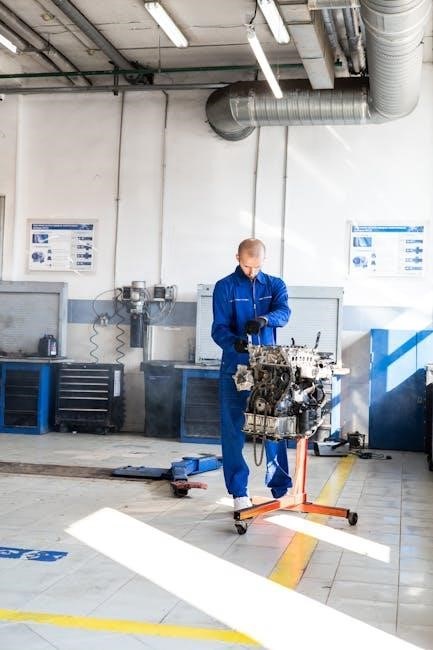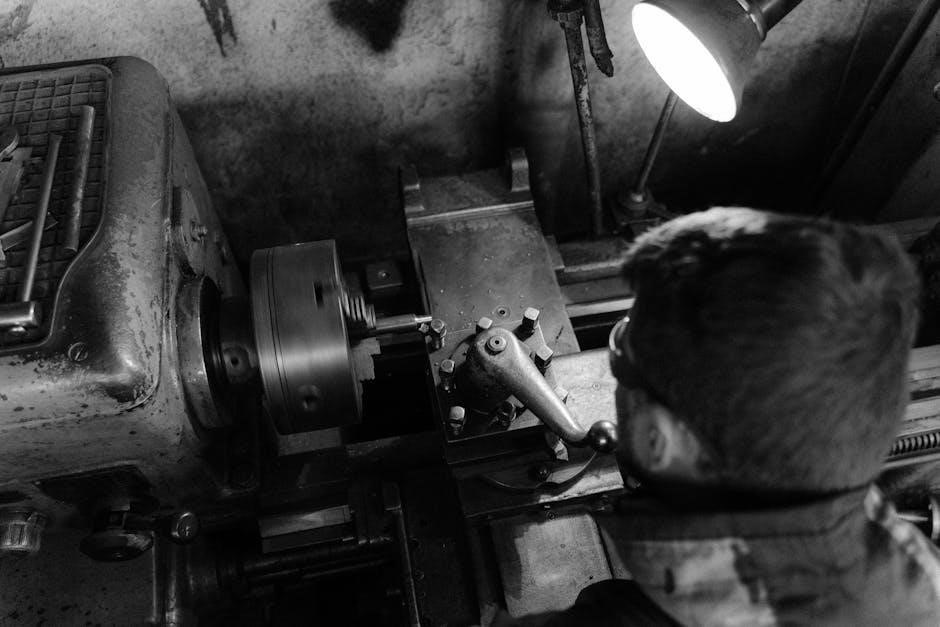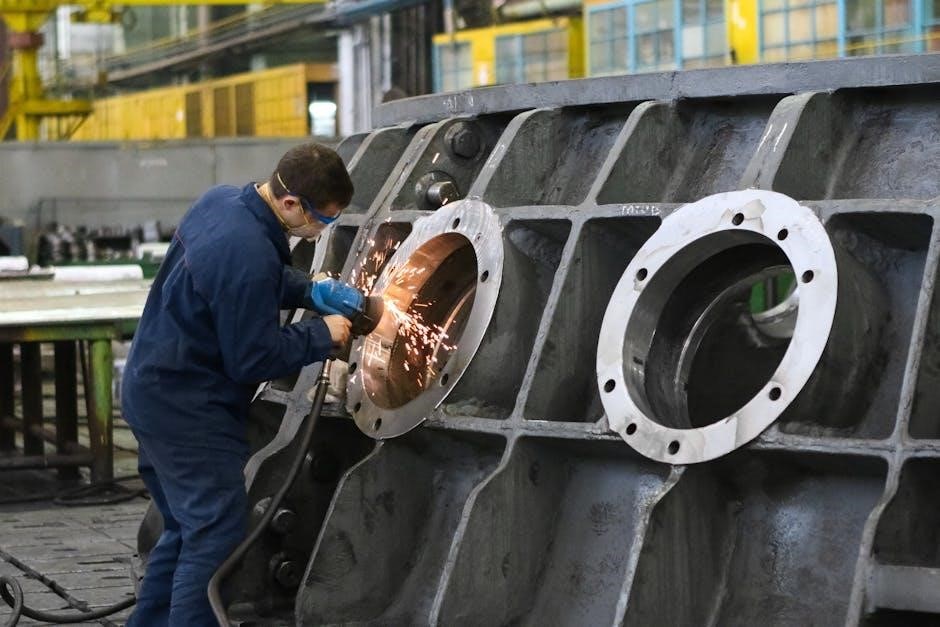Mechanic Labor Time Guides are essential tools for accurate repair estimates‚ optimizing technician productivity‚ and reducing labor intensity in automotive repair. They provide standardized frameworks for estimating repair times‚ ensuring fair pricing and efficient workflows. These guides are widely used in the automotive industry to streamline operations and enhance customer satisfaction. By following these guides‚ technicians can complete repairs more efficiently‚ reducing costs and improving overall service quality. They are a cornerstone for modern automotive repair shops aiming to maximize profitability and maintain high service standards.
What is a Mechanic Labor Time Guide?
A Mechanic Labor Time Guide is a standardized resource providing detailed estimates for automotive repair and maintenance tasks. It outlines the average time required for specific jobs‚ ensuring accurate pricing and efficient workflow. These guides help technicians optimize productivity‚ reduce labor intensity‚ and deliver consistent results. Available as PDFs‚ they offer structured frameworks for estimating repair times‚ enabling shops to streamline operations and enhance customer satisfaction. By standardizing labor times‚ these guides ensure fair pricing and help technicians complete repairs efficiently‚ reducing costs and improving service quality.
Importance of Labor Time Guides in Automotive Repair
Labor Time Guides are crucial for modern automotive repair‚ ensuring accurate estimates‚ optimized technician productivity‚ and reduced labor costs. They provide standardized frameworks for estimating repair times‚ helping shops deliver consistent and fair pricing. By reducing labor intensity and streamlining workflows‚ these guides enhance operational efficiency. Additionally‚ they enable technicians to focus on critical tasks‚ improving overall service quality. With the integration of AI and machine learning‚ labor guides now offer instant data access‚ further enhancing accuracy and efficiency. This ensures shops remain competitive while maintaining high standards of customer satisfaction and compliance with industry norms.

Purpose and Benefits of Mechanic Labor Time Guides
Mechanic Labor Time Guides provide accurate repair estimates‚ optimize technician productivity‚ and reduce labor intensity. They integrate AI and technology for efficient workflows‚ ensuring profitability and customer satisfaction.
Accurate Repair Estimates and Pricing
Mechanic Labor Time Guides ensure precise repair estimates by standardizing labor times for specific tasks‚ eliminating guesswork and overcharging. These guides provide detailed breakdowns of required labor hours‚ enabling shops to set fair and transparent pricing. By referencing these guides‚ technicians can quickly determine the time needed for repairs‚ reducing delays and ensuring customer satisfaction. Additionally‚ AI-powered tools optimize estimates‚ considering factors like job complexity and technician expertise. This accuracy not only streamlines workflows but also builds trust between customers and repair shops‚ fostering long-term relationships.
Optimizing Technician Productivity
Mechanic Labor Time Guides play a crucial role in maximizing technician productivity by providing standardized labor times for repairs. This allows technicians to focus on tasks without unnecessary delays‚ ensuring efficient use of time. By streamlining workflows and reducing downtime‚ these guides help shops complete more jobs in less time. Additionally‚ they enable better allocation of workforce skills‚ ensuring complex tasks are handled by experienced technicians while simpler jobs are assigned to less experienced staff. This optimization enhances overall workshop efficiency and technician performance‚ leading to higher customer satisfaction and business growth.
Reducing Repair Time and Labor Intensity
Mechanic Labor Time Guides significantly reduce repair time and labor intensity by providing precise‚ pre-determined times for specific tasks. This streamlines the repair process‚ allowing technicians to plan and execute jobs more efficiently. Standardized labor times minimize guesswork‚ reducing delays and ensuring tasks are completed within expected durations. By eliminating unnecessary labor hours‚ these guides help shops deliver faster service‚ improve customer satisfaction‚ and maintain a competitive edge. This efficiency also allows workshops to handle more jobs‚ boosting productivity and profitability while reducing operational stress.

Types of Mechanic Labor Time Guides
Mechanic Labor Time Guides include flat rate manuals‚ manufacturer-specific guides‚ and AI-powered systems. Each type provides standardized labor times for accurate repair estimates and efficient workflows.
Flat Rate Manuals
Flat rate manuals are standardized guides that list predefined labor times for specific repairs. These manuals are based on national averages and industry standards‚ ensuring consistency across repairs. By providing fixed times for tasks‚ they help shops create accurate estimates and streamline billing. Technicians rely on these manuals to plan workflows efficiently‚ reducing uncertainty and improving productivity. Regular updates ensure the manuals reflect current repair practices and technological advancements‚ making them indispensable for maintaining consistency and fairness in labor costing.
Manufacturer-Specific Guides
Manufacturer-specific guides are tailored to particular car brands‚ offering detailed repair times and instructions for specific models. These guides ensure accuracy in estimates and repairs‚ helping technicians work efficiently. They often include OEM part numbers and factory standards‚ crucial for maintaining warranties. Regular updates keep them current with new models and technologies. By following these guides‚ shops can deliver high-quality‚ manufacturer-approved repairs‚ enhance customer satisfaction and trust.
AI-Powered Labor Guides
AI-powered labor guides are revolutionizing how repair shops estimate labor times. By leveraging machine learning algorithms‚ these tools analyze vast repair databases to provide precise‚ data-driven estimates. They adapt to shop-specific efficiencies and integrate seamlessly with shop management systems. AI guides enhance accuracy‚ reduce estimation time‚ and minimize errors. They also offer real-time updates‚ ensuring technicians have the latest information. With AI-powered guides‚ workshops can optimize scheduling‚ improve customer satisfaction‚ and ultimately increase profitability. These intelligent solutions are reshaping the future of automotive repair.

Understanding Labor Time Estimates
Labor time estimates are standardized durations for specific repairs‚ ensuring accurate billing and scheduling. They guide technicians‚ enhancing efficiency and customer trust in repair processes.
Factors Affecting Labor Times
Several factors influence labor times in automotive repair‚ including technician expertise‚ repair complexity‚ and availability of tools. Vehicle make‚ model‚ and age also play roles‚ as newer models may require specialized knowledge. Diagnostic challenges‚ such as identifying intermittent issues‚ can extend labor times. Additionally‚ shop workload‚ workflow efficiency‚ and adherence to manufacturer guidelines impact time estimates. Understanding these variables helps create accurate labor time guides‚ ensuring efficient repairs and customer satisfaction while maintaining profitability for shops. These factors highlight the importance of detailed labor time estimates in modern automotive repair processes.
Standardized Framework for Labor Estimates
A standardized framework for labor estimates ensures consistency and accuracy in calculating repair times. It involves predefined procedures‚ such as categorizing repairs by complexity or using specific time units for tasks. This framework often incorporates manufacturer specifications and industry standards to maintain reliability. It also includes mechanisms for updating estimates with new technologies and quality control measures to ensure realistic time allocations. By implementing such a framework‚ shops achieve uniformity in pricing and task management‚ enhancing customer satisfaction and operational efficiency while adapting to industry advancements.

The Role of Technology in Labor Time Guides
Technology has revolutionized labor time guides by enhancing accuracy‚ accessibility‚ and efficiency. Digital platforms provide real-time data access‚ enabling faster‚ more precise labor estimates and streamlined workflows.
AI and Machine Learning in Labor Estimates
AI and machine learning are transforming labor estimates by analyzing vast datasets to predict repair times with greater accuracy. These technologies adapt to new repair scenarios‚ reducing estimation errors and improving technician productivity. Advanced algorithms consider factors like vehicle complexity‚ technician expertise‚ and repair history to generate precise labor times. This innovation enables shops to provide customers with transparent‚ data-driven estimates‚ enhancing trust and operational efficiency. AI-powered tools also automate routine calculations‚ allowing technicians to focus on complex repairs and improve overall workshop performance.
Instant Data Access for Technicians
Instant data access empowers technicians to quickly retrieve labor time estimates‚ enabling efficient repair planning. Digital labor guides provide real-time information‚ reducing downtime and errors. Technicians can access detailed repair procedures‚ diagrams‚ and time allocations on-demand‚ streamlining workflows. This immediate access ensures accurate estimates and faster diagnosis‚ improving customer satisfaction. Additionally‚ it fosters consistency across repair shops‚ as all technicians follow standardized guidelines. With instant data access‚ shops can operate more efficiently‚ complete repairs sooner‚ and maintain higher service quality.

Industry Standards and Compliance
Adhering to industry standards ensures reliable‚ consistent repair practices‚ fostering trust and accountability in automotive services‚ and maintaining compliance with regulatory requirements.
Adherence to Automotive Industry Standards
Adherence to automotive industry standards ensures consistency‚ safety‚ and efficiency in repairs. Labor time guides align with established protocols‚ guaranteeing uniformity across manufacturers and regions. By following standardized procedures‚ technicians ensure compliance with legal and regulatory requirements‚ reducing liability risks. These guides also promote transparency‚ building customer trust through fair and predictable pricing. Compliance with industry standards fosters a culture of accountability‚ ensuring high-quality service delivery. This alignment is critical for maintaining credibility and meeting customer expectations in the competitive automotive repair market.
Ensuring Compliance with Repair Guidelines
Ensuring compliance with repair guidelines is crucial for maintaining quality and safety in automotive repairs. Labor time guides provide detailed instructions and time estimates‚ helping technicians follow manufacturer recommendations and industry best practices. By adhering to these guidelines‚ repairs are completed efficiently and correctly‚ reducing the risk of errors and rework. Compliance also ensures customer satisfaction and avoids legal issues. These guides are structured to include step-by-step instructions and required tools‚ facilitating adherence to safety standards and promoting a smooth repair process.

How to Use Mechanic Labor Time Guides
Mechanic labor time guides ensure compliance with repair guidelines by providing detailed instructions and standardized time estimates. Technicians follow manufacturer recommendations and industry standards‚ reducing errors and rework. These guides include step-by-step procedures‚ required tools‚ and safety protocols‚ promoting adherence to best practices. Compliance ensures repairs are safe‚ efficient‚ and meet legal requirements‚ enhancing customer satisfaction and avoiding potential liabilities. By following these structured guidelines‚ shops maintain professionalism and reliability in their services‚ ensuring consistency across all repairs.

Step-by-Step Guide to Applying Labor Times
To apply labor times effectively‚ start by referencing the mechanic labor time guide PDF for the specific vehicle and repair. Identify the job code or description‚ then locate the corresponding labor time. Add any additional operations or modifications‚ ensuring to account for overlapping tasks. Calculate the total labor time by summing individual task times. Document the estimate clearly‚ including parts and labor costs. Review the estimate for accuracy and present it to the customer for approval. This structured approach ensures efficient and transparent repair planning‚ fostering trust and streamlining workflows.
Best Practices for Technicians
Technicians should always reference the latest mechanic labor time guide PDF for accurate estimates. Stay updated with manufacturer revisions and software updates. Understand the guide’s structure to quickly locate relevant data. Double-check labor times for complex jobs to avoid underestimating. Document custom repairs separately‚ using the guide as a baseline. Adhere to safety and manufacturer guidelines to ensure compliance. Continuous training on new systems and technologies is essential for precise time allocations. By following these practices‚ technicians enhance efficiency‚ accuracy‚ and customer satisfaction‚ maintaining high professional standards.

Case Studies and Real-World Applications
Automotive shops using mechanic labor time guides have reported improved efficiency and customer satisfaction. One shop reduced average repair time by 20% post-implementation‚ enhancing workflow and accuracy;
Success Stories from Automotive Shops
Many automotive shops have achieved significant improvements by implementing mechanic labor time guides. A leading repair chain reported a 30% reduction in repair times‚ boosting productivity and customer satisfaction. Another independent shop saw a 25% increase in service accuracy‚ reducing comeback issues. These guides have also helped shops streamline workflows‚ ensuring consistent labor estimates and fostering trust with customers. By standardizing repair processes‚ shops have enhanced efficiency‚ profitability‚ and overall service quality‚ demonstrating the tangible benefits of labor time guides in real-world scenarios.
Reducing Costs and Improving Efficiency
Implementing mechanic labor time guides has proven to significantly reduce operational costs while enhancing efficiency. Shops report a 20% reduction in labor expenses by minimizing over-time and optimizing technician workflows. These guides also reduce repair errors‚ lowering parts wastage and rework costs. Additionally‚ streamlined processes enable faster turnaround times‚ increasing customer throughput. By standardizing labor times‚ shops can better allocate resources‚ improve inventory management‚ and deliver consistent service quality. This leads to higher profitability and customer satisfaction‚ making labor guides a vital tool for modern automotive businesses.

Future of Mechanic Labor Time Guides
The future involves AI-driven predictive analytics‚ real-time data integration‚ and continuous updates‚ enhancing accuracy and adaptability for evolving vehicle technologies and repair demands efficiently.
Emerging Trends in Labor Time Estimation
Emerging trends in labor time estimation include the integration of real-time data from vehicle sensors and predictive analytics to refine repair time accuracy. Cloud-based platforms are enabling seamless updates and access to labor guides‚ while mobile-friendly interfaces improve technician efficiency. Additionally‚ the rise of AI-driven systems allows for dynamic adjustments based on technician expertise and workshop conditions‚ ensuring more precise estimates. These advancements aim to streamline repair processes‚ reduce downtime‚ and enhance customer satisfaction in the automotive industry‚ making labor guides more adaptable to modern demands.
Innovations in Automotive Repair Technology
Innovations in automotive repair technology are revolutionizing labor time estimation‚ with advancements like AI-powered diagnostics and augmented reality tools enhancing accuracy. Electric vehicle-specific repair systems are emerging‚ alongside eco-friendly practices. Automated diagnostic tools now integrate seamlessly with labor guides‚ reducing manual input and errors. These innovations are streamlining workflows‚ improving technician efficiency‚ and ensuring alignment with the latest industry standards. As technology evolves‚ it promises to further enhance the precision and speed of automotive repairs‚ making labor time guides more essential than ever for modern repair shops.
Mechanic labor time guides are essential tools‚ enhancing accuracy‚ efficiency‚ and cost savings in automotive repairs. They play a vital role in modern repair shops‚ ensuring adherence to industry standards and adapting to future challenges.
Summarizing the Key Points
Mechanic labor time guides are indispensable tools for accurate repair estimates‚ optimizing technician productivity‚ and reducing labor intensity. They ensure adherence to industry standards while providing a standardized framework for labor estimates. By utilizing flat-rate manuals‚ manufacturer-specific guides‚ and AI-powered solutions‚ these guides enhance efficiency and precision. They also facilitate instant data access for technicians‚ ensuring compliance with repair guidelines. Ultimately‚ labor time guides promote consistency‚ customer satisfaction‚ and cost-effectiveness‚ making them a cornerstone of modern automotive repair. Their evolution with emerging trends ensures continued relevance in the industry.
Final Thoughts on the Importance of Labor Time Guides
Mechanic labor time guides are essential for maintaining consistency‚ accuracy‚ and efficiency in automotive repairs. They ensure technicians can deliver high-quality work while adhering to industry standards. By streamlining estimates and reducing labor intensity‚ these guides enhance customer satisfaction and business profitability. As technology advances‚ their integration with AI and real-time data will further revolutionize the industry. Ultimately‚ labor time guides are indispensable tools that foster trust‚ transparency‚ and excellence in automotive repair‚ making them a vital resource for shops aiming to thrive in a competitive market.

Be First to Comment